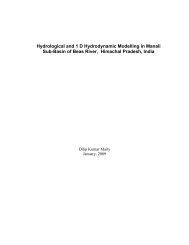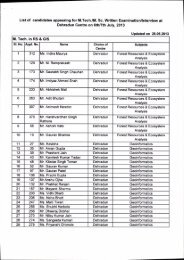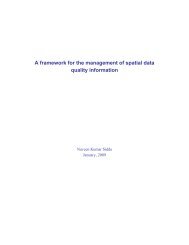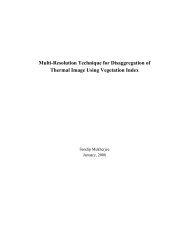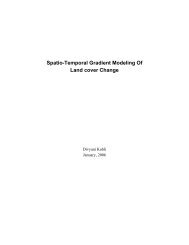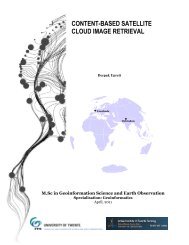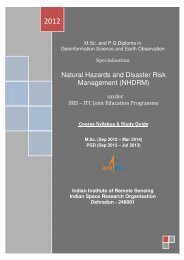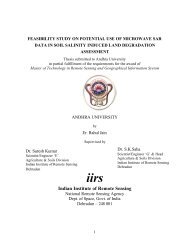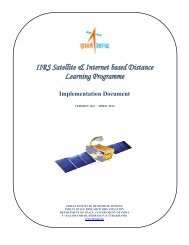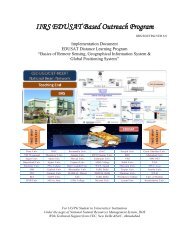Impact of Coal Mining on Vegetation: A Case Study in Jaintia Hills ...
Impact of Coal Mining on Vegetation: A Case Study in Jaintia Hills ...
Impact of Coal Mining on Vegetation: A Case Study in Jaintia Hills ...
You also want an ePaper? Increase the reach of your titles
YUMPU automatically turns print PDFs into web optimized ePapers that Google loves.
IMPACT OF COAL MINING ON VEGETATION: A CASE STUDY IN JAINTIA HILLS DISTRICT OF MEGHALAYA, INDIATable 4.2: Stand density as affected by m<strong>in</strong><strong>in</strong>g <strong>in</strong> different z<strong>on</strong>esSpecies C<strong>on</strong>trol Z<strong>on</strong>e-I Z<strong>on</strong>e-II Z<strong>on</strong>e-III Z<strong>on</strong>e-IVTrees (<strong>in</strong>dividual/ha) 1040 561 515 603 647Shrubs (<strong>in</strong>dividual/m 2 ) 1 2 1 1 2Herbs (<strong>in</strong>dividual/m 2 ) 32 165 178 154 1574.1.3. Dom<strong>in</strong>ance PatternThe dom<strong>in</strong>ance were different for tree, shrub and herb comp<strong>on</strong>ent <strong>in</strong> m<strong>in</strong>ed and the unm<strong>in</strong>ed c<strong>on</strong>trolarea <str<strong>on</strong>g>of</str<strong>on</strong>g> the study area. In terms <str<strong>on</strong>g>of</str<strong>on</strong>g> importance value P<strong>in</strong>us kesiya (IVI: 243.97-280.27) was thedom<strong>in</strong>ant tree species <strong>in</strong> the m<strong>in</strong><strong>in</strong>g area and presented <strong>in</strong> all the z<strong>on</strong>es, which was followed by theSchima wallichii (IVI: 10.05-46.36). In the c<strong>on</strong>trol site Camelia caudata (IVI: 54.5), Castanopsispurpurella (IVI: 44.9) and Quercus griffithii (IVI: 30.7) were the dom<strong>in</strong>ant tree species.In the shrub layer, Eupatorium adenophorum (IVI: 22.78-53.74) and Melastoma nepalensis (IVI:23.36-48.86) were the two dom<strong>in</strong>ant species followed by Lantana camara (IVI: 23.93-49.44) <strong>in</strong>different z<strong>on</strong>es <str<strong>on</strong>g>of</str<strong>on</strong>g> the m<strong>in</strong><strong>in</strong>g area. C<strong>on</strong>trol site was dom<strong>in</strong>ated by Psychotria erratica (IVI: 16.13),Cassia floribunda (IVI: 14.52), Shutaria vestida (IVI: 14.52), and Plectranthus striantus (IVI: 14.52).Am<strong>on</strong>g herbaceous species Paspalum orbiculare (IVI: 68.42-95.47) dom<strong>in</strong>ated all the z<strong>on</strong>es <str<strong>on</strong>g>of</str<strong>on</strong>g> them<strong>in</strong><strong>in</strong>g area, which was followed by Isachne himalaica (IVI: 15.75-19.57). Globba clarkii (IVI:38.73), Selag<strong>in</strong>ella semicordata (IVI: 29.52) and Panicum brevifolium (IVI: 24.13) were the dom<strong>in</strong>antground species <strong>in</strong> the c<strong>on</strong>trol site (Table 4.3).The high importance value <str<strong>on</strong>g>of</str<strong>on</strong>g> P<strong>in</strong>us kesiya <strong>in</strong> m<strong>in</strong><strong>in</strong>g areas suggest<strong>in</strong>g its ability to grow <strong>in</strong> thedisturbed envir<strong>on</strong>ments and its dom<strong>in</strong>ance <strong>in</strong> the harsh c<strong>on</strong>diti<strong>on</strong>s. Higher importance value <str<strong>on</strong>g>of</str<strong>on</strong>g> Schimawallichii <strong>in</strong>dicates the degraded envir<strong>on</strong>ment. The higher importance value <str<strong>on</strong>g>of</str<strong>on</strong>g> Paspalum orbicularesuggests that it can multiply rapidly <strong>in</strong> the disturbed envir<strong>on</strong>ments. This perennial grass by virtue <str<strong>on</strong>g>of</str<strong>on</strong>g> itsstol<strong>on</strong> and root<strong>in</strong>g at each node can b<strong>in</strong>d the soil particles, mak<strong>in</strong>g the soil more stable. The dom<strong>in</strong>ance<str<strong>on</strong>g>of</str<strong>on</strong>g> <strong>on</strong>e or two species expla<strong>in</strong> the low diversity and high dom<strong>in</strong>ance <strong>in</strong> the m<strong>in</strong>ed affected areas.Dom<strong>in</strong>ance-diversity curves have been used to <strong>in</strong>terpret the dom<strong>in</strong>ance <str<strong>on</strong>g>of</str<strong>on</strong>g> species <strong>in</strong> the community <strong>in</strong>relati<strong>on</strong> to resource apporti<strong>on</strong>ment and niche space (Whittaker, 1975). The curves (Figure 4.1, Figure4.2, Figure 4.3) <strong>in</strong> the unm<strong>in</strong>ed sites resemble the log normal suggest<strong>in</strong>g that there was more or less aneven apporti<strong>on</strong>ment <str<strong>on</strong>g>of</str<strong>on</strong>g> resources am<strong>on</strong>g the members <str<strong>on</strong>g>of</str<strong>on</strong>g> the important species. The curves for them<strong>in</strong>ed sites resemble with broken-stick series model (Poole, 1974). This could be attributed to thelesser number <str<strong>on</strong>g>of</str<strong>on</strong>g> species occurr<strong>in</strong>g <strong>in</strong> these areas and also represent a stress envir<strong>on</strong>ment wherec<strong>on</strong>diti<strong>on</strong>s were not favourable for plant growth. Species diversity was low <strong>on</strong> these stands, but thespecies that grow here appear to have developed tolerance that enable them to grow <strong>in</strong> such anenvir<strong>on</strong>ment.31



